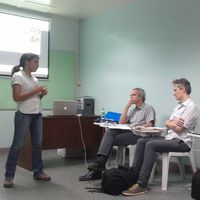A Conversation With Alexis A. Tioseco
Alexis, can you tell us more about your backgrounds as a film critic and the instigator of Criticine website ?I first began writing about cinema seriously roughly 4 years ago, after the premiere of Lav Diaz's Batang West Side. I was born in the Philippines, but educated in Vancouver, Canada up to mid high-school, before returning to Manila to finish my high school and college. I was very much into film, and enjoyed writing, but did not take Philippine cinema very seriously at the time. Batang West Side served as an eye-opener for me on two levels -- the first being the plight of my people, and the second being Philippine cinema. I had not taken Philippine cinema very seriously before seeing Batang West Side, and probably for a good reason as much of contemporary Philippine cinema at that time was garbage. Batang West Side had opened me up to the possibility that we could produce great cinema in the Philippines, serious cinema, and also that we needed to -- to cause ourselves to reflect and examine our conditions. It was in seeing how little support an important film like Batang West Side received and how little serious critical attention it was met with that I began to take seriously the role of writing about cinema... of being a film critic.
The idea of Criticine was hatched roughly a year and a half ago, in May 2004, while participating in the Conference on New Southeast Asian Cinemas organized by Dr.Khoo Gaik Cheng at the Asia Research Institute in NUS, Singapore. At the time I was writing for a website called Indiefilipino.com that covered independent films and music in the Philippines (though I only wrote about films). The dialogue instigated by that Conference created an energy, an interest, a desire to know more about the other cinemas in Southeast Asia, and for that information to be made available to the public in order to open up lines of communication between the different countries and encourage dialogue. There was so much that we have to learn from each other, what was needed was simply a platform for doing so.
What made you want to make a site dedicated to South East Asian cinema? What could be the differences between different South East Asian cinemas? And what do SEA filmmakers have in common?
As Philip Cheah points out in his introductory essay for the Whose Terror is it Anyway? programme that he curated for the House of World Cultures in Berlin, and Benjamin McKay touches on in the opening of his essay Toward New Ways of Seeing Southeast Asian Cinema for Criticine, the term 'Southeast Asia' was coined during the Cold War for the purposes of geographical and political containment, i.e. map-making by oppressors. While not uniform across the board, I think that the most common history that Southeast Asians share relates to the origin of that term-- that of first being colonized, and then, as Philip Cheah's programme implicates, state-led terrorism.
What was the reason for creating a site dedicated to Southeast Asian cinema? Quite simple-- there wasn't one. The culture of film criticism in the Southeast Asian region is a very poor one, with to my knowledge not one single serious print film journal in existence in the english language (there are film journals in Thailand, but they are predominantly in the Thai language). Film, I believe, plays such a crucial role in the region, but our culture of film appreciation is so poor. Perhaps the lack of serious writing on film made available to the public is one of the reasons for this.
How did you get into other SEA cinema?
My curiosity was piqued after that initial Conference in Singapore.Not only does Southeast Asia (in pockets) have a rich cinematic heritage, but so many interesting and vital things were happening cinematically in the region today, that one couldn't help but want to see more. And in seeing more, one couldn't help but want to read insights into these works by people knowledgeable about the cultures and societies from which these works were born.
Concerning your website, how did you find and federate all the contributors?
Each person who contributed to the first issue of Criticine were people that I had met personally, most while travelling around Southeast Asia this past year, and are among the film writers and cultural commentators I most respect in the region. Dr.Khoo Gaik Cheng (academic and professor, having taught in University of Victoria, University of British Columbia, National University of Singapore, and now Canberra), Benjamin McKay (completing his post-doctoral dissertation on 50's and 60's Singapore and Malaysia as revealed to him by the locally produced films of that era at Charles Darwin University), Hassan Muthalib (a filmmaker, educator, and historian who co-wrote the Malaysian chapter of Being and Becoming: The Cinemas of Asia) and Rolando Tolentino (a visiting professor at NUS, former director of the UP Film Institute, editor of Geopolitics of the Visible: Essays on Filipino Film Cultures ) were all people I first met in person during the aforementioned Conference on New Southeast Asian Cinemas, and met again, often more than once, in the year that followed-- at festivals, conferences, and seminars held in Cebu, Singapore, and Manila. Lisabona Rahman and Paul Agusta were introduced to me by Indonesian filmmaker and curator Lulu Ratna while in Jakarta. Lisa was a member of the 2004 Berlinale Talent Press. I was part of the 2005 Talent Press, so she told me what to expect and gave me some good tips on how to maximize my time at the Berlin Film Festival. Paul wears many hats-- is an experimental filmmaker, film critic, and curator in Jakarta. Both he and Lisa, as well as John Badalu, were people constantly cited when I asked who were important voices on contemporary Indonesian cinema. Vinita Ramani, an impressive young writer and critic, I was in touch with over a year before meeting in person at this year's Singapore International Film Festival (where she was head of the Publicity department). Noel Vera I met in Manila, naturally, on several occasions, and is the contemporary Filipino film critic I respect the most. Raya Martin, the young filmmaker writing a journal as a resident of the Cannes Cinefondation programme in Paris I met several years ago. We were interviewed at the same time to become contributors to the college section of the Philippine Daily Inquirer.
These are the esteemed contributors to the first issue, but the contribution base is one that I hope and expect to expand. There are many great writers, critics and thinkers out there whose voices we need to hear from, many young writers whose voices we need to develop, and, in the case of certain countries whose writers are more comfortable in their native language, many texts we need to begin translating.
As explained on the site, most of the discourse on SEA cinema was made by foreigners (western or Northern Asian, I suppose). Did this bring some misconception or some clichés to the analysis of these works?
Cliches and misconceptions do exist-- they definitely do exist, but more than that, the most pressing things were simply the redundancy of ideas that you would read in the writing. When reading them, one is forced to ask themselves, why do they exist? The answer that I came up with is that they were often written from a surface perspective, or by someone with a limited knowledge of the particular culture/region. This isn't something that is peculiar to Southeast Asia, but holds true for writings about cinema from all around the world (read reviews of films shown in Cannes by critics from all around the world, and often you will only find one interesting or insightful review in the lot of 10 or 20).
Cinema is a universal language, people say, and that is true, but it also has many nuances- in form, content, symbols- that are particular to the place in which the work was made.
Some festivals have been doing special programs on SEA cinema (Pusan, Rotterdam, etc..). Do their choices reflect the reality or do they miss something? Do you think these festivals look down on some particular types of films, contemporary popular cinema for example?
It is fortunate that the ones handling the programming, such as Gertjan Zuilhof for Rotterdam's S.E.A. Eyes, are very good at what they do, and more often than not spot the difference between the truth and the exotic. I learned a lot and discovered new films from examining the programme Gertjan put together. But doing this also led me to question-- should we need to learn about cinema from the region from someone outside of it? Gertjan is a very good programmer and a very nice man, but I don't think that we should rely on him to be updated on contemporary happenings in the region-- for his sake as well as ours, we shouldn't.
It is also a blessing that Gertjan put the S.E.A. Eyes programme together, because it allowed both him and International Film Festival Rotterdam to become acquainted more intimately with Southeast Asian filmmakers and their work, which is aiding these filmmakers now in their applications for the Hubert Bals Fund; an excellent programme that gives grants twice a year to promising projects, works-in-progress, and finished films from developing countries. A number of SEA filmmakers have benefited from this -- Lav Diaz, Khavn Dela Cruz, Raya Martin, Woo Ming Jin, Tan Chui Mui, Ho Yuhang, Riri Riza, and Ravi Barwani, to name but a few.
Could we say that most of SEA filmmakers have to work in guerrilla-style (except Thailand maybe) because of the lack of finance and government support? Can you elaborate on that aspect? Was the rise of new generation of filmmakers made possible with the DV and other digital formats?
It is true that many Southeast Asian filmmakers must work independently, not just because of a lack of government support, which is important, but because the films they are making are not always ones that will be popular with mass audiences.
This new generation has almost entirely been made possible because of DV. Most SEA countries are developing countries, and their film industries are still developing (despite, in the case of countries like the Philippines, being around for close to a decade already). The Asian Economic crisis took its toll on our local industries.
DV will have the biggest impact on countries with the smallest or worst cinemas. Why? Because it will give those filmmakers options. But DV doesn't ensure quality films. Not by a long shot. It is simply a much cheaper medium-- an affordable tool by which artists can express their ideas about the world. Countries like Malaysia are simply lucky that the pioneers in DV filmmaking there-- U-Wei Haji Sari, Amir Muhammad, James Lee, and Ho Yuhang, have been such great leaders.


